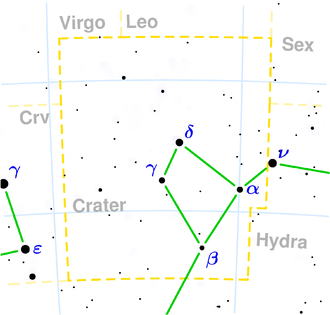IC 2623
| Galaxie IC 2623 | |
|---|---|
 | |
| AladinLite | |
| Sternbild | Becher |
| Position Äquinoktium: J2000.0, Epoche: J2000.0 | |
| Rektaszension | 11h 03m 50,9s[1] |
| Deklination | -20° 05′ 35″[1] |
| Erscheinungsbild | |
| Morphologischer Typ | E[2] |
| Helligkeit (visuell) | 13,5 mag[2] |
| Helligkeit (B-Band) | 14,5 mag[2] |
| Winkelausdehnung | 0,8′ × 0,5′[2] |
| Positionswinkel | 70°[2] |
| Flächenhelligkeit | 12,5 mag/arcmin²[2] |
| Physikalische Daten | |
| Zugehörigkeit | isoliert |
| Rotverschiebung | 0.012682 ± 0.000123[1] |
| Radialgeschwindigkeit | 3802 ± 37 km/s[1] |
| Hubbledistanz vrad / H0 | (162 ± 11) · 106 Lj (49,6 ± 3,5) Mpc [1] |
| Geschichte | |
| Entdeckung | Herbert A. Howe |
| Entdeckungsdatum | 19. April 1900 |
| Katalogbezeichnungen | |
| IC 2623 • PGC 33418 • ESO 569-033 • MCG -03-28-034 • 2MASX J11035096-2005347 • GALEXASC J110350.93-200533.2 • LDCE 729 NED205 • 2MIG 1537 | |
IC 2623 ist eine elliptische Galaxie vom Hubble-Typ E4 im Sternbild Becher am Südsternhimmel. Sie ist schätzungsweise 162 Millionen Lichtjahre von der Milchstraße entfernt und hat einen Durchmesser von etwa 40.000 Lichtjahren.
Das Objekt wurde am 19. April 1900 von Herbert Alonzo Howe entdeckt.[3]
Siehe auch
Weblinks
Einzelnachweise
Auf dieser Seite verwendete Medien
Autor/Urheber: Sloan Digital Sky Survey, Lizenz: CC BY 4.0
The sky image is obtained by Sloan Digital Sky Survey, DR14 with SciServer.
Angle of view: 4' × 4' (0.3" per pixel), north is up.
Details on the image processing pipeline: https://www.sdss.org/dr14/imaging/jpg-images-on-skyserver/



